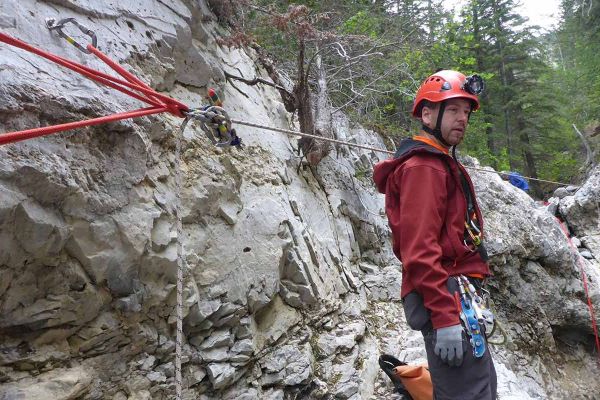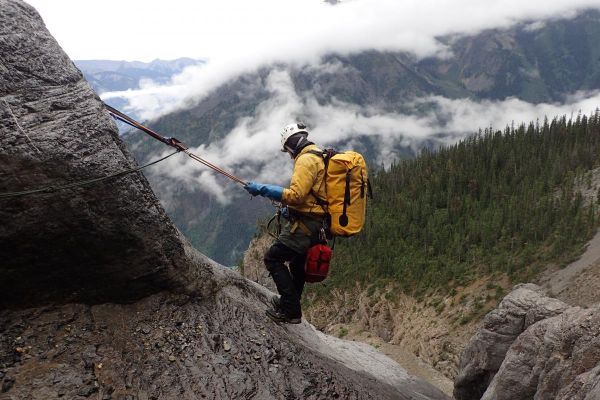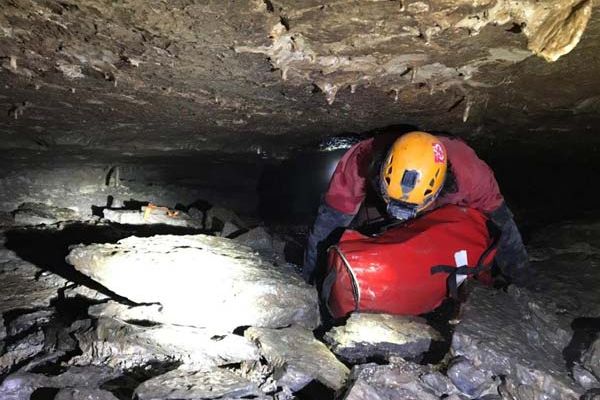
CONSERVATION. EDUCATION. EXPLORATION

CONSERVATION. EDUCATION. EXPLORATION
Welcome.
The Alberta Speleological Society (ASS) is an organization open to anyone interested in the sporting or scientific aspects of caves and karst formations in the Rocky Mountains, and who is willing to visit them in a safe, environmentally - responsible manner.
-
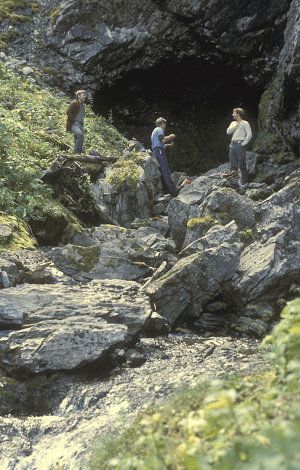
Welcome
Lower Entrance, Fang CaveWe are one of several caving clubs in Canada and have informal connections with many caving organizations in the US. and worldwide. Our present membership of nearly 100 cavers ranges from first-time novices to seasoned veterans with international caving experience. We are the recognized caving authority in the province of Alberta, and our dedication to the exploration, study, and conservation of caves in the Canadian Rockies has helped set standards in Canada for the last fifty years. We are happy to advise governments, agencies and other stakeholders on issues related to cave management, and we actively support the separate Alberta/BC Cave Rescue Service.
The Alberta Speleological Society promotes the conservation of physical and biological features within caves, to preserve them in their natural state and to foster within the general public an appreciation of caves as a valuable natural resource. We have conducted cleanup and restoration work where appropriate and we support the activities and values of the Canadian Cave Conservancy and various bat conservation groups.
If you have come across a possibly - undiscovered cave or have sighted bats within a cave, there are reporting buttons on our "Contacts" page. If you discover and report a previously-unknown cave, you may be eligible for a free one-year Society membership and some cool swag. If it turns out to be a discovery of some significance, you will also be consulted about the naming of the cave (there are certain conventions which need to be observed), and if you are both interested and sufficiently skilled / physically capable, have an opportunity to accompany our experienced cavers inside for some exploration!
-
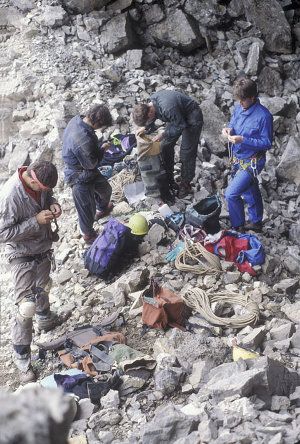
Who We Are
Flop PotFirst and foremost we are a caving club, and our main emphasis will always be on enjoying known caves, and searching for, exploring, and mapping new discoveries. Our membership is spread across the province of Alberta (and beyond), spans all age groups, and encompasses experience levels from beginner cavers to old hands. Some of our members are extremely active cavers while others support the club passively.
Over a 50 - year period, the Alberta Speleological Society has become the primary authority on caves and karst in Alberta, because of our well-documented activities in the Rockies, the scientific and practical expertise of some of our members, and our ability to network with cave experts in other parts of the world. We are also the province's major special interest group on cave issues.
-
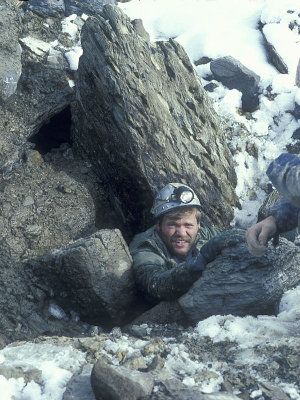
What We Do
Chute of Many CrawlersExecutive members handle most of the boring political and organizational stuff, while our members focus on going caving. However we generally have very few formal club outings - each year we might schedule one or two trips for members, and may occasionally organize an expedition to a remote area for experienced cavers, usually advertised in the events calendar or newsletter. Most activities are informally arranged between members of similar interest and ability levels who make their own trips. You might hear about them at the pub night, or read about them afterwards in the newsletter, or not hear about them at all. A new member should therefore not expect the trips to come to him/her, but should be willing to take the initiative to find out what's happening, or organize their own trips. Executive members can help out with information or permit applications, if required, for caves that are within your experience and abilities. They can also advise you how to get started if you are a beginner.
Technical equipment ('tackle') is available at no charge to any member in good standing; contact your tacklemaster to see what the local arrangements for sign-out are. All tackle must be returned promptly after use in a clean and organized state (some facilities have rope washing tools), and must be signed back in so the club can keep track of what's where. Tackle stores typically include ropes of various lengths, steel cable ladders, survey equipment, rope protectors, rope bags, and some also have digging tools, scaling poles and miscellaneous stuff, but we do not lend personal equipment such as lights, helmets or harnesses. Some tackle stores also have a 'bash kit', designed to provide emergency comfort and basic first aid to an accident victim; these are designed to be left in the car trunk or base camp until needed. [Note that full-blown cave rescues will normally be handled by the government first-responders with jurisdiction in the area, assisted upon request by the Alberta/BC Cave Rescue Service (ABCCRS).] It is the responsibility of the individual caver, not the Alberta Speleological Society, to ensure that borrowed tackle is in good shape and is used properly and safely. All caving equipment is potentially dangerous if misused. If you have spotted a piece of equipment you're not sure about, contact your Tacklemaster for advice.
Some chapters hold informal pub nights, where most of the club caving activities are planned. Non-members are very welcome. Dropping by is a good way to meet cavers, tap into the information pool, and have an enjoyable evening too. These are publicized in our event calendar.
The Alberta Speleological Society has a small library of past club newsletters and special interest items, some in electronic form accessible through this website and some in hard copy. If you are interested in signing something out or just want to browse, please contact the Archivist. Items can also be mailed, or photocopied upon making prior arrangements. There is no charge for members using the library unless mailing/shipping arrangements have been made. A periodic newsletter (the Journal of Subterranean Metaphysics) is posted on the members section of this site, as is a database of caves.
Under our bylaws, we must have one Annual General Meeting per year, usually in late November or early December; we often also have a Semi-Annual General Meeting in June or July. At both the AGM and SAGM, club business is discussed and motions are made and voted on. Executive and committee members conduct the day-to-day business in between. We always have a social event associated with each general meeting, usually a very informal dinner for a nominal fee (as a fund-raiser) followed by a party often including slide shows and sometimes a squeeze machine or other caving activities. It's a lot of fun and a great way to meet other cavers. You don't have to be a member to attend any part of this, but you must be a member to vote. Periodically the executives hold Board of Directors' meetings or teleconferences to discuss club business. Although not intended for the general membership, attendance by interested members is generally not a problem. Contact the Secretary for meeting details.
-
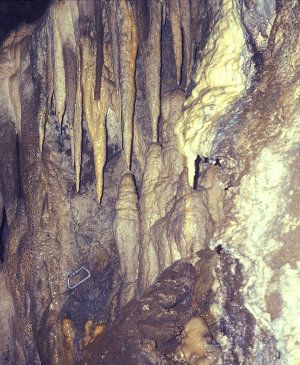
What We Believe In
Beauty Cave (Queen Charlotte Islands)Although we do not actively promote caving to the general public, the Alberta Speleological Society is receptive to new members, provides information to organizations and individuals, and works with federal and provincial governments on cave management issues.
Our ethics prohibit damaging the cave environment or making collections of any kind; photographs are much more meaningful, and most cave formations lose their lustre and appeal when taken from the high humidity environment anyway. Spray painting, scratching, chipping or other permanent or semi-permanent markings for identification, direction finding or other reasons is unnecessary vandalism. Littering or leaving any food or human waste underground is thoughtless laziness and can harm some cave biota; we often remove the litter of other inconsiderate visitors. Some caves have decorated or delicate floors, requiring keeping to a low-impact path or removing boots altogether (not too many in the Rockies though). A few caves contain delicate ice crystals, so open-flame light sources are inappropriate and visitation should be limited because of body heat. Many caves house hibernating bats, which should not be disturbed as a premature metabolism change could result in their death. After the arrival of White Nose Syndrome (WNS) in the Americas, it has become critically important to properly decontaminate all caving gear & clothing after each trip, and not to take any of these items into a cave at all if previosuly used in a known WNS area. There are some exploration priorities that, though controversial, have a conditional acceptance amongst cavers, including digging and breaking of barriers. It must be stressed, however, that each instance is considered on its own merits, none are undertaken lightly, and damaging the cave is considered an extreme measure that is only undertaken when the probability of a significant discovery greatly exceeds the damage required.
The Alberta Speleological Society does not hold formal training sessions for new members. Most cavers learn their skills by seeking advice and visiting the easier caves with more experienced companions, working through a range of difficulties over the years. There are also private and some university courses in beginner caving available. Some of the most valuable caving traits are self-reliance, level-headedness, and common sense.
The Alberta Speleological Society has never claimed responsibility for cave rescues. We believe that safety is the responsibility of each individual caver within their underground team, and that in the event of an accident it is the individuals involved, not the club, who are responsible for their actions and any costs associated with a rescue attempt. Self-rescue, where possible, is most strongly recommended, unless moving the victim would result in further injuries. Rescues requiring outside assistance are coordinated by the first-response agency with jurisdiction in the area (usually the local RCMP) who may engage help from the Alberta/BC Cave Rescue Service. The Alberta Speleological Society has no obligation to provide assistance to a cave rescue, but each individual member has the option of volunteering their assistance, if they wish. If you want to learn more about cave rescue, contact ABCCRS.
Caving is a sport that, like science, very much builds on the achievements of others, in terms of equipment and technique development, but also in terms of surface searches, surveying, and making new discoveries in existing caves. For these reasons, cavers everywhere document their new finds. In Alberta, written descriptions and surveys of new cave passages, and sometimes surface searches, should be submitted to our newsletter, the Journal of Subterranean Metaphysics. Original or transcribed survey notes or electronic files should be retained (personally or in the club library) even after the survey has been published, so that subsequent extensions to the cave can be added to the data. Any discoveries thought to be of wider interest should also be submitted to The Canadian Caver, Canada's national caving journal. The Alberta Speleological Society and other clubs provide limited financial support to The Canadian Caver, and encourage all cavers to subscribe.
In the happy but rare event of discovering virgin cave passage, some basic courtesies should be followed. It is considered poor ethics to partake in the enjoyment of exploring a new discovery without participating in the often-challenging task of surveying and documenting. It is also unfair to be the first to explore someone else's discovery without their knowledge or consent - far better to be part of a team exploring together. Caves and passages are usually named by their discoverers and surveyors, but are almost never named after them ("Bob's Cave") or, for that matter, after any living person. Exceptions are caves that already have local names, which should not be changed. The permanence of the 'first name' is why cavers should take care to name their discoveries artfully and well rather than frivolously and without forethought.
-
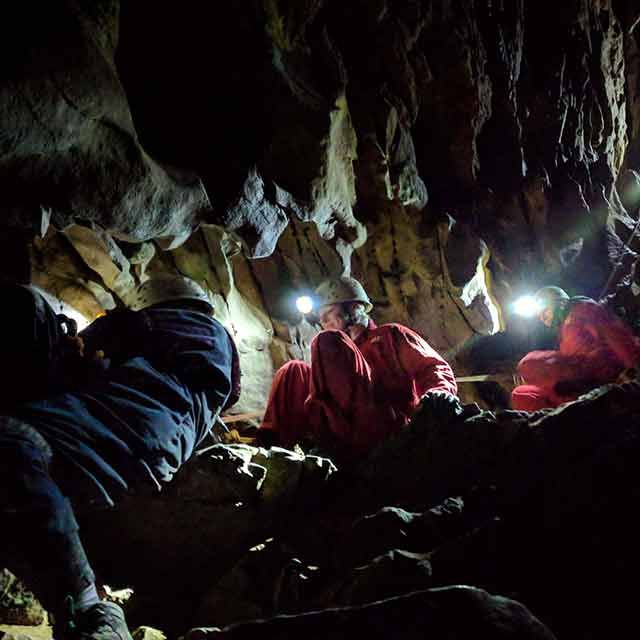
How do I get Into Caving?
- 1. Generally we suggest that if you haven’t been caving before, you start out with one of the ‘wild cave’ tours offered by a commercial operator, such as Canmore Cave Tours (CCT) - or Cody Caverns or Horne Lake in BC. If you like it and have fun, go to step 2. If not, you will still have a nice adventure tale to tell. Also keep your eye out for courses or specialty tours which are occasionally offered by these commercial operators (when there’s no pandemic restrictions).
- 2. Joining the Alberta Speleological Society is your next logical next step. Although we are not a formal training or certification agency, membership will enable you to be aware of and sign up for some fun caving with an experienced trip leader, such as at our “Bring-a-Friend Day”, Semi-Annual General Meeting Weekend” or other field events. More importantly, you will make contacts with other cavers and become aware of self-organized trips among our members, which are always more numerous than the "club" events. Getting mentoring from advanced cavers and gaining experience on actual trips is a terrific way to gradually build your skills and confidence.
- 3. If you want to get very far into caving in the Alberta/BC Rockies, where the caves tend to have a significant vertical component, you are definitely going to want to learn Single Rope Technique (SRT) and acquire the necessary gear -- some of which is deliberately different from standard climbing gear, for example, sit harnesses with a lower attachment point and fewer loops). Please note that while prior experience in rappelling, rock or ice-climbing etc. is certainly helpful, you willneed to learn some specialized techniques to handle vertical caving safely and efficiently. Regrettably there are infrequent opportunities in Alberta these days for formal courses in SRT, but you can also learn by mentoring from experienced members of our club. We sometimes schedule SRT practices at a climbing gym in town or on the cliffs outside Rat's Nest Cave.
- 4. Take on a variety of progressive challenges with cavers who have skills, experience and goals with which your are comfortable. After that, you can branch out in many ways, from continued “tourist caving” to serious expedition caving, take courses with the US National Speleological Society, become involved in the Alberta/BC Cave Rescue organization, or participate in events organized by sister caving clubs in BC or Montana, for example. Caving is as wide as it is 'deep'!
-
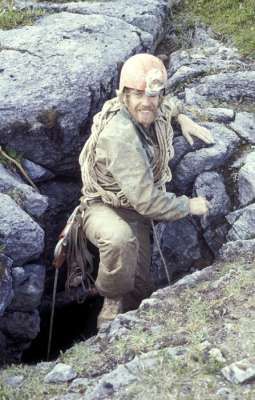
Club History
Chas Yonge, M1 Pitch, Porcupine CaveIn the spring of 1968 Dave Doze searched for cavers in the Calgary area, starting with a membership list of the National Speleological Society. The resulting eight persons decided to establish a province-wide, provincially registered club with formal bylaws defining its executive and financial structure. Sequential membership numbers were considered, but dropped; this and an open membership laid the basis for a non-elitist club. The Alberta Speleological Society was incorporated under the Societies Act on October 11, 1968, with the following objectives:
"To locate, survey and map caves; to collect and classify data pertaining to the science of speleology, including cave geology, biology, hydrology, ecology and related disciplines. To promote the conservation of all physical and biological features; to prevent the pollution of the cave environment. To foster an appreciation of the value of caves as a natural resource, in those persons controlling the disposition of caves, and the general public. To cooperate with the efforts of individuals whose interests are compatible with the aims of this society."
Over the next fifty years, the Alberta Speleological Society grew into a successful 100+ member organization with an enviable record of original cave exploration and safe, responsible recreational caving. The success of these activities is primarily the result of the hard work of the individual members involved; the Society itself only facilitates these accomplishments by providing equipment, information, and a social and inspirational context that encourages teamwork and success.
-
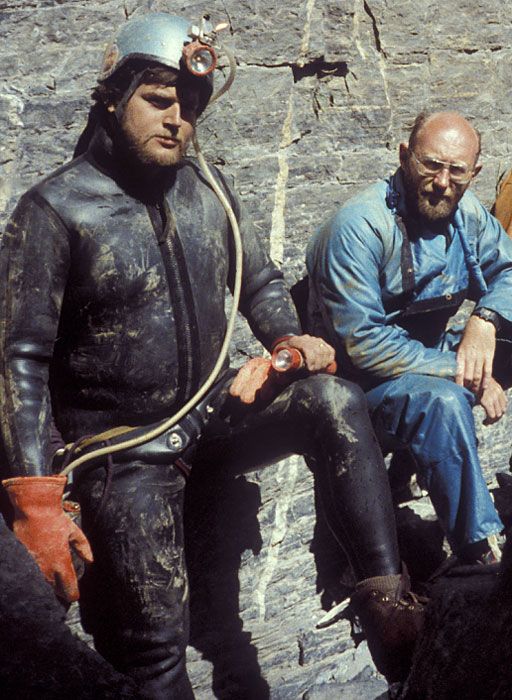
Cave Exploration
Bluebell ResurgenceIn 1968, only Canyon Creek Ice Cave and Cadomin Cave were known to the club, and only Canyon Creek had been visited by any of the members. Although cavers from McMaster University (Hamilton, Ontario) had held summer field camps in the Rockies since 1965, most of their work had been independent of the Alberta Speleological Society activities until 1971 when there was some participation on trips organized by the McMaster University Caving and Climbing Club. These McMaster cavers spearheaded many of the “big” Rockies explorations between 1967 and 1973, including Castleguard Cave, Yorkshire Pot, Gargantua and Arctomys Cave. Throughout the 70s many of the key cavers in this group moved west and joined the Alberta Speleological Society, and this influx of primarily ex-British talent and energy became a defining element in the club’s attitudes and abilities, resulting in a blend of American and European caving styles.
The mid-1970s witnessed a slowdown of caving in the Rockies, with modest discoveries being made by one or two keen individuals and some important participation by members on Vancouver Island explorations. Perhaps the cream of Rockies caves had been taken, but this period may have reflected a loss of personal energy as well.
Another ballooning of activity occurred between 1980 and 1988, partially because of a willingness to use helicopters to open up remote caving areas, partially as a spin-off of a succession of British expeditions to the Rockies, and partially the result of a new wave of energetic novices. This period began with important new discoveries at Crowsnest Pass, most of which have since connected with Yorkshire Pot. Other discoveries and explorations included Fang Cave, Porcupine Cave, White Hole, Dezaiko Cave and Moon River Cave, all in the north and central Rockies and many of which ended up on the 'top ten' of Canada’s ‘longest and deepest list at the time. As well, Alberta Speleological Society cavers were the first to document caves on the Queen Charlotte Islands, and participated in the exploration of some of the deepest caves on Vancouver Island. This busy period ended on a high note with the ‘bottoming’ of a 254m deep shaft in Close To The Edge, thought at that time to be one of the 50 deepest shafts in the world.
In the 1990s activity again dropped off dramatically, perhaps the result of the aging or retirement of key cavers, but there has been a burst of activity in the new millenium. Close To The Edge was revisited and deepened to 470m, now the third deepest in Canada, and Lost Light Cave has become the longest cave within Jasper National Park. But in contrast to the 1980s, it is the southernmost areas of the Canadian Rockies that have received the most attention, including exploration of the vertical Ptarmigan Cave (over 300m deep), Pellet Factory with its metres-deep packrat poo and wind-sculpted ice formations, the voluminous passages of River-Gone Dream Cave, and the self-describing Thin Man's Temptation. Many new caves have recently been discovered and explored in the Mt. Doupe area, three of which are over 250m deep and one (Heavy Breather) is over 500m deep and is poised to break the long-standing Canadian depth record.
For the future, the potential for new Rockies discoveries remains high for cavers with the requisite time and energy.
Cavers like travelling with their sport. Alberta Speleological Society members have initiated or participated on caving trips or expeditions to Alaska, Australia, Belize, Bolivia, China, Costa Rica, Cuba, the Dominican Republic, England, France, Guatemala, Haiti, Hawaii, Hungary, India, Ireland, Jamaica, Japan, Mexico, New Guinea, New Zealand, Norway, Peru, Sardinia, Wales and the continental USA. A few Alberta Speleological Society members have moved overseas and have reported explorations in Australia, Bhutan, the Cook Islands, Indonesia and Japan in our newsletter.
-
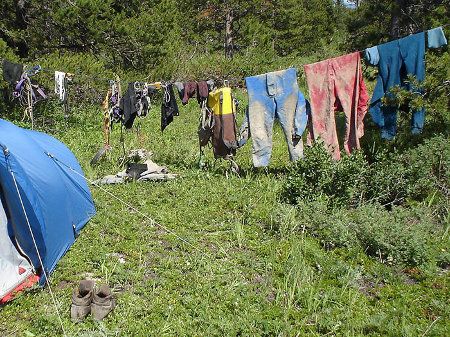
Club Evolution
Emerald Lake CampsiteThe early years focused on attempts to increase club membership, expand the club’s knowledge of Rockies caves, and formalize the club structure. At first the small membership held monthly general meetings in Calgary and later in Edmonton, which were more practical and effective than a regular newsletter. By 1970 membership had reached 21 persons; 10 in Calgary, 6 in Edmonton and 5 elsewhere. In addition to caving, club activities included informational talks, practical instruction, guiding of groups upon request through Canyon Creek Ice Cave, and performing cave cleanups. Publicity to attract new members and information about caves included display booths, handouts, and even radio was considered.
By the late-70s, however, concerns over public safety and environmental damage led to the cessation of publicizing either the club or caving, and the Alberta Speleological Society became somewhat reclusive. Club guidelines such as the Leader Policy, Safety Policy and Membership Sponsorship fell into disuse and the club’s membership remained static at about 15 to 20 people. The Alberta Speleological Society gained the reputation of being uncooperative and unfriendly, and relations with Parks Canada deteriorated.
However the public's interest in caving mushroomed in the mid 1980s and the Alberta Speleological Society gradually responded by participating in cave management deliberations with governments, liaising with mountain rescue organizations, becoming receptive to public inquiries, producing handouts on cave etiquette, safety, and the club’s organization and beliefs, and establishing a web-page. By 1981, membership had grown to 33; in 1984 it had reached 70; in 1994 it had reached 100. The Alberta Speleological Society bylaws were revised to better reflect the club’s current practices and were registered with the province in 1993.
From the mid-90's to the present the club has continued to grow slowly and has maintained cooperative relationships with other caving - related organizations and regulatory agencies. Today the Alberta Speleological Society is the primary authority on caves and karst in the Alberta Rockies, with an open and helpful membership and executive, although we still stop short of actively promoting the sport to the non-caving public.
Newsletter
The first issues (from 1968) of an irregularly appearing newsletter featured a cover drawing of a donkey wearing a helmet and carbide lamp, looking back over its hindquarters. A more formal publication, the Alberta Speleologist, covered the more important cave discoveries, but was terminated in 1973 after three issues as it was duplicating the function and content of Canada's national journal, The Canadian Caver. The newsletter also faltered, but was revived into a bimonthly format in 1978, then less frequently based on whenever there was news to print. In 1983 a computer word-processor was first used and the somewhat tongue-in-cheek name Journal of Subterranean Metaphysics (JOSM) was adopted; issue numbering began in November 1989 (with an arbitrary #100), and a regular, quarterly format was established in 1993. More recently JOSM moved to an electronic publlishing format; back editions are available on this site. No doubt technology will result in further improvements in the future.
Website
A no-frills version of an Alberta Speleological Society website first appeared around 1996. In November 1998 member Terry Wachniak presented a template for an expanded site with upgraded graphics, and by January 2000 the first website under the current domain name was fully functional. Major text expansion and modifications occurred between 2003 and 2004, and the overall look of the website was updated in 2008.
-
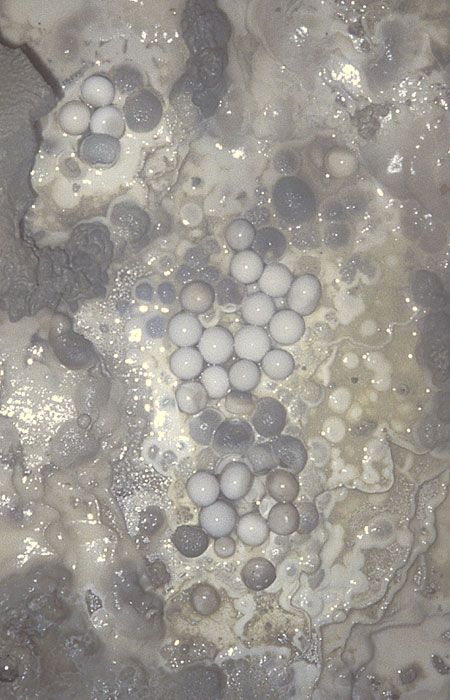
Cave Management
Cave PearlsAlthough the Alberta Speleological Society does not own or otherwise control any caves, we do maintain a high interest in their protection and, in most cases, continued free access to those caves on public lands. We believe that federal and provincial government agencies can make better management decisions if they utilize our special knowledge of cave resources.
After the Alberta Speleological Society was formed in 1968, initial interest and activity on cave management centred on those caves close to Calgary that were known to the public. Regular cleanups and group guiding at Canyon Creek Ice Cave were slowed and finally suspended when the resident ranger closed the access road. High public awareness and visitation to Plateau Mountain Ice Cave resulted in the Alberta Speleological Society supporting an Alberta Forest Service proposal to gate the cave, which was accomplished in 1972. In 1975 the Alberta Speleological Society opposed the routing of a segment of the proposed Great Divide Trail over the Ptolemy/Andy Good Pass; the trail concept died five years later when the sponsoring GDT Association became inactive. In 1979 the Alberta Speleological Society requested the support of the Federation of Alberta Naturalists in opposing a proposal to quarry a limestone ridge near Cleft Cave at Crowsnest Pass, which was also a test of the province's Zone 1 Prime Protection designation.
During 1979 and 1980 the Alberta Speleological Society wrote to the Province of BC expressing concern over its proposed Cave Management Policy, and periodically has supported BC cavers in their own battles over cave conservation. We have supported the ongoing influencing and consulutation efforts of the Canadian Cave Conservancy in BC and Alberta since its inception in 1986 and rebirth in 2002.
Concerns over public safety at Castleguard Cave resulted in Parks Canada installing an ineffective gate in 1975 and creating restrictive legislation in 1973, 1975 and 1978 that was never enforced. In 1982 the Alberta Speleological Society participated in the Four Mountain Parks Planning Process and, although the legislation was not repealed, caving was recognized as a legitimate sport within national parks and commitments to work with the Alberta Speleological Society on cave management issues was achieved in 1986. Although a new, effective gate was installed without consultation on Castleguard in 1990, permits for skilled cavers became easier to obtain as relations between the Alberta Speleological Society and Parks Canada thawed. An Alberta Speleological Society proposal to provide Parks Canada with information on national parks caves resulted in Jon Rollins’ Masters thesis on cave management and a cave inventory in 1992.
Parks Canada proposals for Nakimu Caves and the Cougar Valley have oscillated between total area closure and grandiose plans for development, at one point including an aerial tram up the valley. The Alberta Speleological Society has consistently advocated retaining a wilderness setting while allowing self-propelled visitation by competent parties, and is not in agreement with the 1995 ‘user-pay’ policy whereby a fee is charged although no facilities are provided.
The existence of the well-decorated Rat’s Nest Cave was kept secret until the early 1980s, even amongst Alberta Speleological Society membership, due to its proximity to a paved road. There was mixed support for the provincial historic site designation and gating in 1986, but at present, the Alberta Speleological Society supports the concept of paid guided tours in Rats’ Nest Cave, with an ability for experienced cavers to obtain permits for access to the extensive 'wild side' of the cave.
In 1994 the Alberta Speleological Society initiated contacts with provincial agencies concerning recommendations for low-key management at Cadomin Cave, including informational signage, monitoring and continued free access. Periodic cleanups and continuing discussions with the province led to the Alberta Speleological Society becoming official Stewards of the cave, and in 1999 we were awarded an Outstanding Group Steward Award by the province. The creation of Whitehorse Wildland Provincial Park gave the cave much-needed protection, and the Alberta Speleological Society continued to take an active role in the formulation of management plans for the park. Periodic cleanups at Cadomin had to be suspended when the cave was closed by ministerial order in 2010 (extended in 2015) in an attempt to prevent the spread of White Nose Syndrome (WNS); however the Society continues to assist with such activities as bat counts under the auspices of provincial wildlife biologists.
Rumors of proposed helicopter tours of the Small River Karst resulted in proposals for a highly restrictive ecological reserve, or inclusion into Mt. Robson Provincial Park. The Alberta Speleological Society preferred the latter, but instead the area was formed into Small River Caves Provincial Park .
In 2009, the Alberta Speleological Society joined forces with the Alberta Fish and Wildlife to monitor caves for the appearance of White Nose Syndrome in local bat populations. We have assisted in placing or retrieving roost logger devices as well as feeding in observations of bats which may be made during caving trips. We have also supported the efforts of the Wildlife Conservation Society of Canada in its BatCaver program.
More recently we have provided input to the province on the 2017 creation of the Castle Wildland Provincial Park, which includes a valuable caving area on the Andy Good Plateau near Crowsnest Pass.
Today the Alberta Speleological Society liaises with government agencies, other caving groups, rescue & conservation organizations, etc. and is receptive to public inquiries. We provide guidance on cave etiquette, safety, and the club’s organization and beliefs, and maintain this web page as a service to cavers and non-cavers alike.
-
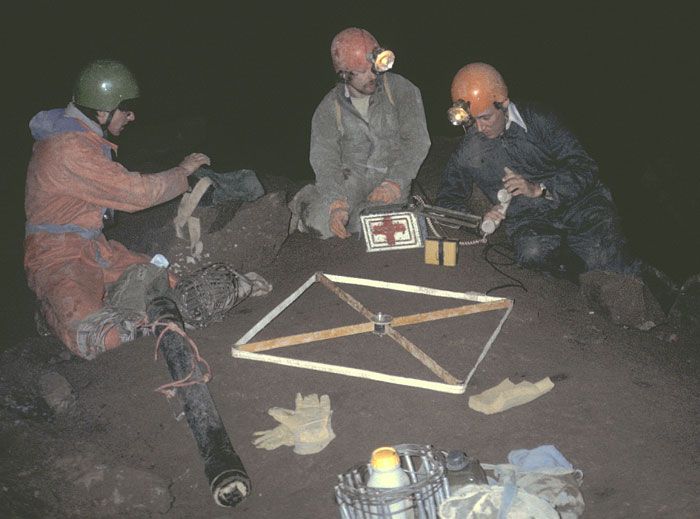
Caving Technology
Using the Cave RadioIan Drummond and other members of the Alberta Speleological Society began designing and building portable, long-wave radio transmitters/receivers capable of operating through solid rock in 1980, when the technology was in its infancy. With the help of modest grants from the Alberta Speleological Society and the province of Alberta, successful "cave radio" models with ranges of several hundred metres were built, some of which remain in service with caving clubs throughout North America today. The Alberta Speleological Society contributions, both practical and theoretical, were reported at the 1997 world caving congress in Switzerland and have influenced cave radio design around the world. A cave radio is useful to cavers in two ways: it permits voice communication between surface and underground teams, and can be used to determine relative locations of transmitter/receiver by measuring radio wave geometry. Voice communication is important to coordinated activities between surface and underground teams - during a cave rescue, for example. Radio location can be used to verify the accuracy of a cave survey, direct a surface team searching for a possible 'back entrance' to a cave, or even assist with attempted connections between two separate caves.
Recognizing the shortcomings of other cave mapping computer programs, Taco van Ieperen created a user-friendly program called On Station in the mid-1990s, and later made the program open-source. Although other good survey software has since been developed, On Station remains popular with many cavers.
Many cavers have worked on the mapping of Castleguard Cave, but because this 20km long cave is very linear, the sheer scale of producing a detailed map on paper defied the best efforts of cavers for decades. In 2005 Dan Green applied computer software to the problem, and finalized the survey as an innovative navigable PDF file. For more information see Castleguard Cave Survey.
Another useful Alberta Speleological Society innovation is the "caver counter", a small device that counts and records the number of visitors to a particular cave passage. These are easily hidden from view and, as they are light-activated, do not erroneously 'count' bats or other nonhuman visits.
The Alberta Speleological Society membership includes a number of accomplished photographers, who have overcome the unique challenges of the underground environment by building small, light-activated flash triggers which coordinate multiple flashguns without cable connections. (For advice on improving your own cave photographs using an inexpensive disposable camera, see Point and Shoot.)
Yep, Caves are Pretty Amazing.
Upcoming Events
Public Events
Recent Articles
Here are the most recent public articles from the Alberta Speleological Society. To see all of our public articles visit the Archive
All Public Articles
-
2022-11-11 01:34:34
-
2021-01-05 04:41:24
